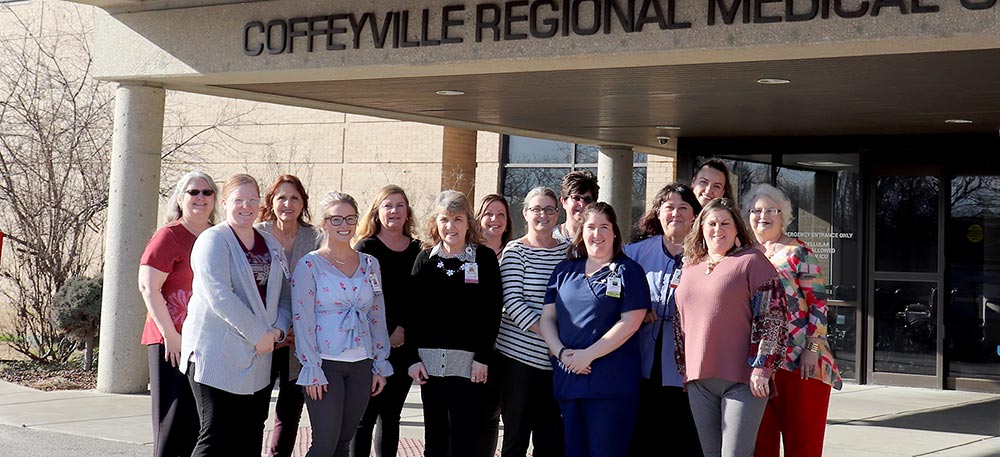Spotlight: Holton Community Hospital achieves 46% reduction in readmissions amid COVID-19
Hospitalizations account for nearly one-third of the total $2 trillion spent on health care in the United States, according to the Institute for Healthcare Improvement. Though most hospitalizations are necessary, too often patients are re-admitted soon after their initial hospital stay. Such readmissions are both costly and often avoidable.
Holton Community Hospital (HCH) in northeast Kansas achieved a 46% improvement in their Unplanned All Cause 30-Day Readmissions Rate between September 2020 and February 28, 2022. Through their work with HQIC and the KHC, they implemented a unique Readmission Risk Assessment and developed a proactive approach to care coordination, which resulted in the dramatic improvement of the hospital’s readmission rate.
Coffeyville Regional: Improving early recognition and treatment of sepsis
 Team members at Coffeyville Regional Medical Center.
Team members at Coffeyville Regional Medical Center.
Quality Improvement Goal: By January 1, 2020, the hospital aimed to improve to 100% adherence to all three-hour sepsis resuscitation treatment bundle guidelines.
Following a Joint Commission survey in December 2018, the team at Coffeyville Regional Medical Center (CRMC) realized they had taken an eye off the ball when it came to sepsis. They identified a gap in early identification of Systemic Inflammatory Response Syndrome (SIRS) criteria and organ dysfunction, as well as implementing appropriate CMS sepsis core measure interventions—specifically nurse-driven interventions.
Labette Health slashed readmissions by 43% since 2012 — here's how
 Some of the more than 700 team members at Labette Health.
Some of the more than 700 team members at Labette Health.
Quality improvement goal: Our goal was to reduce avoidable readmissions to as near to zero as possible.
We started in partnership with the Kansas Healthcare Collaborative in 2012 through the Hospital Engagement Network (HEN) 1.0, HEN 2.0, and the current Hospital Improvement Innovation Network (HIIN). Since then, we have grown in how we approach and monitor performance improvement projects. Early on, this institution felt that readmissions reduction was a quality department-driven objective — but over the course of this and other projects, we have seen a culture change in institution. Directors and front-line staff see the quality department as a tool and as support for accomplishing ambitious goals.
Dramatically reducing patient falls at Osborne County Memorial Hospital
 Osborne County Memorial Hospital team members (from left) include Cindy Hyde, Risk Manager; Kristen Hadley, Quality Improvement Coordinator; Lori Rothenberger, RN and Assistant Director of Nursing; and Monica Mullender, RN and Director of Nursing.
Osborne County Memorial Hospital team members (from left) include Cindy Hyde, Risk Manager; Kristen Hadley, Quality Improvement Coordinator; Lori Rothenberger, RN and Assistant Director of Nursing; and Monica Mullender, RN and Director of Nursing.
Quality Improvement Goal: Reduce patient falls with injury by 30% or more from 2018 to 2019.
The quality improvement team at Osborne County Memorial Hospital (OCMH) is led by Quality Improvement Coordinator Kristen Hadley. By participating in the statewide Hospital Improvement Innovation Network (HIIN) led by the Kansas Healthcare Collaborative (KHC), Hadley and her team have access to comparative data reports that help inform and guide the hospital’s quality improvement efforts.
“Our data reports indicated that we were coming in higher than the state average for falls,” Hadley said. “Leadership was on board from the beginning when we made a commitment and priority to preventing falls with injury.”
Satanta District Hospital testimonial
“My personal experience with KHC has been instrumental in changing the way we do things here. Through the camaraderie and sharing of ideas and information for making changes we have achieved a team that is always ready to rise to any challenge that is put before us.
Because we are a very small CAH, we need help with designing programs that impact patient care, family involvement and nurse and physician participation, we have found a wonderful resource in KHC. I have called or sent emails whenever we have something that we want to work on.
Coffeyville Regional Medical Center - Culture of Safety
Coffeyville Regional Medical Center - Culture of Safety
Click here to view the 2017 AHA Rural Conference Coffeyville Regional Medical Center’s storyboard video that highlights a Culture of Safety improvement project at their facility in Coffeyville, Kansas.
Click here to read more. (PDF)
Wesley Medical Center - Sepsis Case Study
Wesley Medical Center
HEN 2.0 Sepsis Case Study
Click here to view the video
Labette Health - Adverse Drug Events Case Study
Labette Health
HEN 2.0 Case Study: Adverse Drug Events
Click here to view the video
